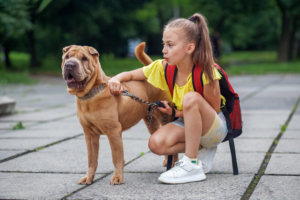As summer fades and the school year approaches, families across the country start preparing for the return to a more structured routine. While this transition is exciting for parents and kids alike, it can be a challenging time for our pets. At Family Friends Veterinary Hospital, we understand that your pets are an important part of your family, and changes in routine can have a significant impact on their well-being. In this blog, we’ll explore how pets are affected by schedule changes when kids go back to school and provide tips to help them adjust smoothly.
How Schedule Changes Affect Pets
Pets, like humans, thrive on routine. They become accustomed to specific patterns of activity, feeding, playtime, and rest. When these patterns are disrupted, it can lead to stress, anxiety, and even physical health issues. Understanding the potential effects of schedule changes on your pets can help you take proactive steps to ease their transition.
Separation Anxiety
One of the most common challenges pets face when kids go back to school is separation anxiety. During the summer, your pets have likely enjoyed the constant presence of their human family members. When everyone suddenly leaves for the day, pets may feel confused, lonely, and anxious. This is especially true for dogs, who are known to form strong bonds with their human companions.
Signs of separation anxiety can include:
-
- Excessive barking, whining, or howling
- Destructive behavior, such as chewing furniture or digging
- Accidents in the house, even if your pet is house-trained
- Pacing, trembling, or restlessness
- Excessive drooling or panting
Changes in Daily Routine
Pets are creatures of habit, and any changes to their daily routine—such as feeding times, bathroom breaks, and exercise—can cause confusion and stress. If your pet is used to being fed at a certain time or going for a walk every morning, any alterations to this routine can disrupt their sense of security.
Potential issues arising from routine changes include:
-
- Skipped meals or overeating due to changes in feeding schedules
- Accidents in the house if bathroom breaks are delayed
- Increased restlessness or hyperactivity from lack of exercise
- Disrupted sleep patterns
Decreased Interaction and Stimulation
With kids back in school and parents busy with work, pets may experience a decrease in social interaction and mental stimulation. Dogs and cats need regular engagement to stay happy and healthy. Without enough attention, they may become bored, which can lead to behavioral problems.
Signs of boredom and under-stimulation include:
-
- Destructive chewing or scratching
- Obsessive behaviors, such as licking or grooming
- Excessive vocalization, such as barking or meowing
- Withdrawal or depression
Emotional Impact
Pets are highly sensitive to the emotions of their human family members. The stress and excitement that often accompany the back-to-school season can affect your pets’ emotional well-being. They may become more anxious, clingy, or even exhibit signs of depression as they sense the shift in the household dynamic.
Tips to Help Your Pets Adjust to Schedule Changes
While the back-to-school transition can be challenging for your pets, there are several strategies you can employ to help them adjust more easily. By taking a proactive approach, you can minimize the impact of schedule changes and ensure your pets continue to feel secure and loved.
1. Gradually Adjust Their Routine
To help your pets adapt to the new schedule, start making gradual adjustments to their routine in the weeks leading up to the first day of school. If you know your pet’s feeding or walking schedule will change, slowly shift these activities to the new times. This gradual transition will help your pets acclimate without feeling overwhelmed.
2. Create a Calm and Comfortable Space
Designate a quiet, comfortable area in your home where your pet can retreat when they’re feeling anxious or stressed. This space should include their bed, favorite toys, and perhaps a piece of clothing with your scent. A safe and cozy space can provide your pet with a sense of security during the day.
3. Increase Mental Stimulation
To combat boredom and keep your pet mentally stimulated, provide them with interactive toys, puzzle feeders, or treat-dispensing toys. These activities can engage your pet’s mind and keep them occupied while the family is away. For dogs, rotating toys can help maintain their interest and prevent boredom.
4. Maintain Regular Exercise
Physical activity is essential for your pet’s physical and mental health. Ensure your pet gets regular exercise, especially before you leave for the day. A brisk morning walk or a play session can help expend excess energy and reduce anxiety. For cats, interactive play with toys like feather wands or laser pointers can help keep them active.
5. Practice Short Departures
To help your pet get used to being alone, practice leaving the house for short periods before the school year starts. Begin with just a few minutes and gradually increase the time you’re away. This practice can help reduce your pet’s anxiety when the full school routine begins.
6. Use Positive Reinforcement
Reward your pet with treats, praise, or extra affection when they handle the new routine well. Positive reinforcement can help reinforce good behavior and make the transition smoother for your pet. Celebrate their successes, whether it’s staying calm during your absence or adapting to a new feeding schedule.
7. Consider Pet Companionship
If your pet struggles with being alone during the day, you might want to explore options like doggy daycare, hiring a pet sitter, or arranging playdates with other pets. Having companionship during the day can significantly reduce feelings of loneliness and anxiety.
8. Monitor Behavior and Seek Professional Help if Needed
Keep a close eye on your pet’s behavior during this transition period. If you notice any signs of severe anxiety, destructive behavior, or changes in eating or bathroom habits, consult with your veterinarian. They can provide additional guidance and may recommend anxiety-reducing treatments or products, such as pheromone diffusers, anxiety wraps, or even short-term medication.
9. Keep Departures and Arrivals Low-Key
Pets can become anxious if you make a big deal out of leaving or coming home. Try to keep your departures and arrivals low-key to avoid triggering anxiety. A calm, quiet exit and return can help your pet feel more secure and less anxious.
Final Thoughts
The back-to-school season brings about changes that can affect every member of your household, including your pets. By understanding the impact of schedule changes and taking steps to help your pets adjust, you can ensure they continue to feel safe, secure, and loved. Remember, a little preparation can go a long way in easing this transition for your furry friends.
At Family Friends Veterinary Hospital, we’re here to support you and your pets through every stage of life. If you have any concerns about your pet’s well-being during this time of change, don’t hesitate to reach out to us. Our team of compassionate professionals is committed to helping your pets live their happiest, healthiest lives.





